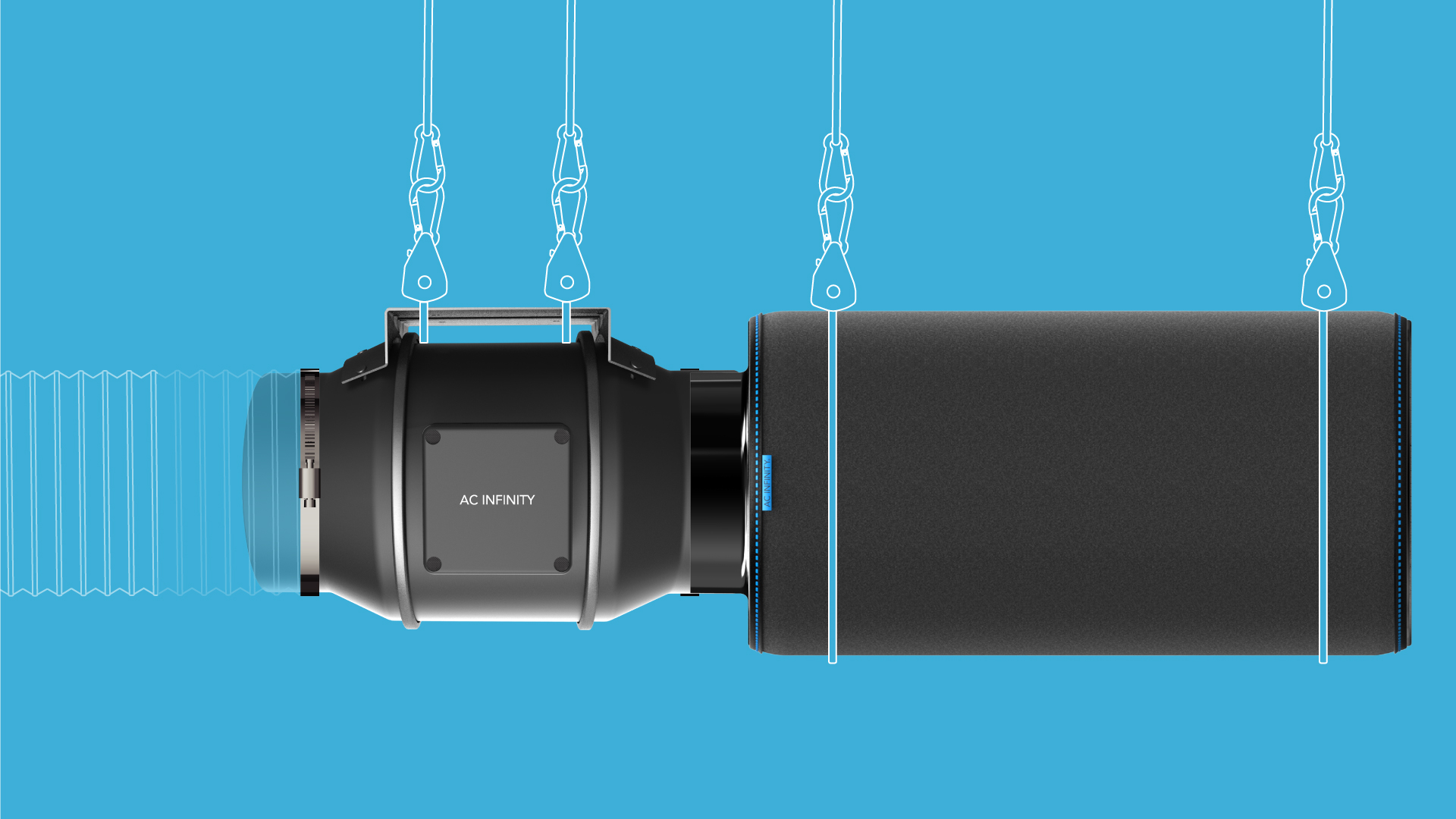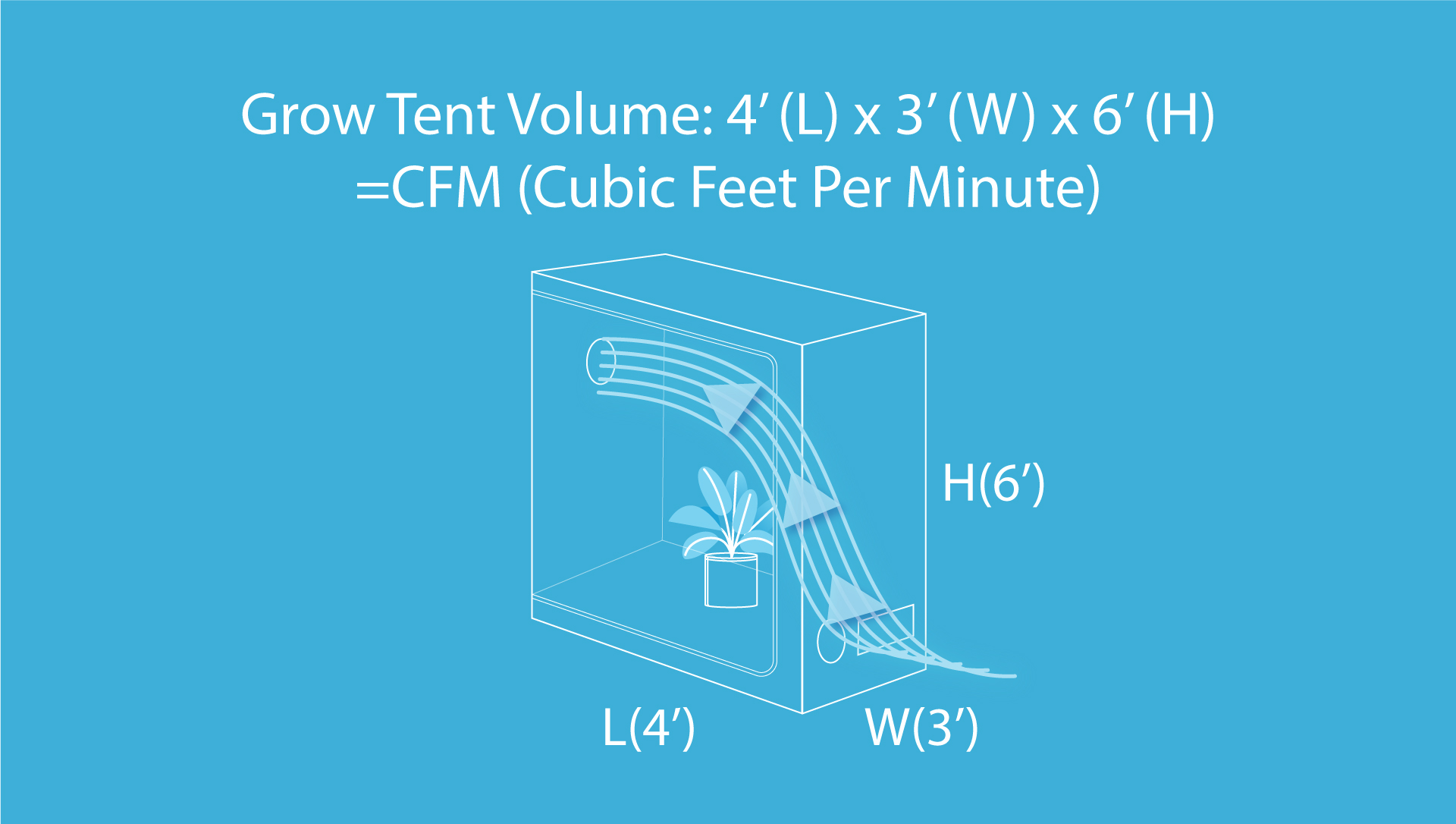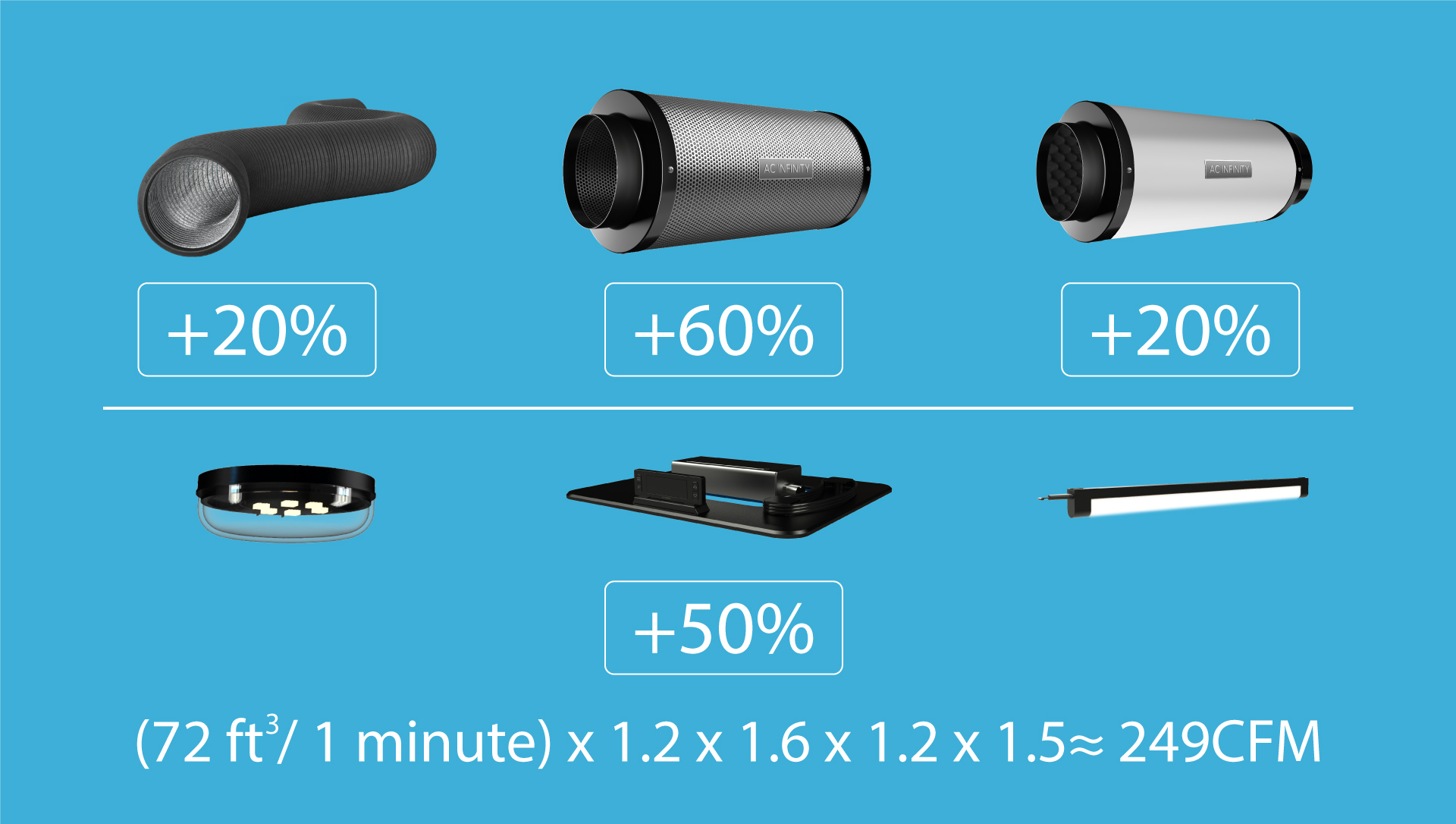Ventilation is a vital factor in your plant growth. By supplying fresh air from outside your grow tent, you provide CO2 for your plants, driving their photosynthesis. At the same time expelling the air inside will keep temperature and moisture build-up under control, preventing mold and mildew from forming on your plants’ leaves, inhibiting growth. Refreshing the air inside has the added benefit of removing strong odors. The following guide will show you what you need to know about setting up your ventilation system.
Essential Grow Tent Parts
This guide is written with the assumption you have already chosen or purchased your grow tent but is also applicable if you are operating in a grow room. These are the three vital components you need to create a ventilation system:

Inline Duct Fan (Active Exhaust Fan)
Also called an extractor fan, an inline duct fan is used to expel the hot and humid air from inside your grow room or tent. Slight changes in temperature and humidity can greatly affect your chances of producing a successful yield. Furthermore, unchecked heat and humidity create poor growing conditions where your plants are unable to absorb water or simply cannot survive. So, it’s important to have a way to manage your grow space’s climate in the form of an inline duct fan.
Because you will be growing in an enclosed space, it will be hotter than the environment outside. Using an active exhaust fan to bring in cooler air will help you regulate the internal temperature. The location of your grow space will affect how hard your inline duct fan will work, which is largely dependent on how well your grow space is insulated.
In ventilation systems using passive intake, inline duct fans also act as a vacuum that brings in air carrying fresh CO2.
Duct Tubes
Ducting is clamped or taped onto your inline duct fan, acting as a channel to route the stagnant air away from your grow space. They are usually made of aluminum but are occasionally multilayered for extra protection from tears. Its size and bends affect how your inline duct fan performs but more on this later.
Carbon Filter
To prevent odors from spreading out towards your garage or closet, you will need a carbon filter. Also called carbon scrubbers, this tool pulls the smell of plants from the air, catching the odor to neutralize it. For growers who deal with especially strong aromas, carbon filters are a must. They are also used to trap pollen and spores, keeping the air clean for growers with allergies and breathing issues like asthma.
Typical Grow Tent Setups
There are many ways to configure these components to bring airflow into your grow space. A typical setup places the fan and the filter inside, which makes it easier to manage while dampening the fan noise. Both can be situated in any order within the ventilation chain if air is being pulled out of your grow space.
For example, your grow lights might get in the way of your cooling equipment. In this case, you may set the fan and/or filter outside of your grow tent.
We recommend setting your extraction fan at the highest point possible. Since heat rises to the top, exhausting that hot air at that point will make the ventilation process efficient. Your carbon filter will also perform better if it’s positioned at the highest point.
What Size Inline Fan do I Need?
There are various sizes of grow spaces, each requiring a different amount of airflow to ventilate them. Exchanging stale air inside with fresh air from the outside of your grow space is vital for optimal plant growth. This figure is measured in CFM or cubic feet per minute.
To find the amount of airflow needed for your grow space, first find its volume in cubic feet. Most grow tents’ measurements are given to you in inches, so convert your space’s dimensions from inches to feet. Then multiply its length by its width and height. This will equal your grow space’s volume, with the required airflow equal to this figure in cubic feet per minute, or CFM. Here is what the formula looks like:

For example, a 48”x36”x72” grow tent converted to feet would be a 4’x3’x6’ grow tent. Multiplying the dimensions together would equal 72 ft3. Since a grow space’s volume is also the required CFM to ventilate it every minute, this grow tent’s base CFM is 72. Hold on to this number, as you will have to account for the ducting, carbon filter, and other accessories you might add.
Factoring in Accessories
The next step is to increase your base CFM by your accessories’ efficiency percentages. Adding components like ducting and carbon filters will reduce fan performance in your grow space which affects the fan size you need.
When it comes to ducting, the number and sharpness of its bends factor into the airflow resistance. This is because airflow reduces the further it must travel so the straighter the ducting route the better. The sharper the bend, the harsher the efficiency reduction; a 30° bend cuts the amount of airflow by 20% while a 90° bend diminishes airflow by 60%! Smoothing out any wrinkles can also improve fan performance and airflow.
If you are using LED grow lights, you must also account for its heat output which further increases your required CFM by up to 50%.
These factors add to your required CFM, which calls for a high performing fan in order to move the calculated airflow. Because accessories on the market can greatly vary, you can use estimated efficiency percentages depending on the type of component.
(Base CFM x Component factors) x (Grow light heat) = Required CFM
For example, our 4’x3’x6’ grow tent has a baseline CFM of 72. We multiply this figure by the efficiency percentage of each component. If we add a carbon filter (60%), ducting (~20%), and a silencer (20%) to our ventilation system, we get 166 CFM. From here, factoring in your grow light’s heat output (≤50%) will give us a required CFM of 249. Keep in mind that these percentages are not fixed and may vary. Here is the breakdown of this calculation:
 Multiplying your base CFM (72) by the ducting (20%), carbon filter (60%), silencer (20%), and grow light heat (50%) of your choice will yield about a required 249 CFM.
Multiplying your base CFM (72) by the ducting (20%), carbon filter (60%), silencer (20%), and grow light heat (50%) of your choice will yield about a required 249 CFM.When shopping for a fan system, we recommend one with fan speed controls and a 25% or greater CFM rating than your minimum requirement, especially if using a filter. This will allow the fan to run quieter at lower speeds and give you room for future grow space system expansion. Look for inline duct fans that use DC fan motors that operate the quietest compared to AC fan motors. PWM-controlled EC motors are acoustically acceptable as well.
How to Manage Grow Space Noise
When using a high-powered fan to ventilate your grow space, you will undoubtedly hear some noise. You wouldn’t want to hang out in an area with noise pollution for too long or draw attention from your neighbors. Fortunately, you can make the component selection with silencing in mind and take additional measures to make your grow space church silent.

Choosing a fan with speed controls and a 25% higher CFM rating than your minimum requirement will allow you to run the fan at lower speeds without sacrificing performance. Whether you are growing a tent or a room, you can apply soundproofing all around your grow space to diminish the fan humming. To add further silencing to your active exhaust fan, you can attach a silencer that will dampen the intake sound. You may also opt for insulated ducting instead of using standard ducting to reduce the whooshing wind noise.







